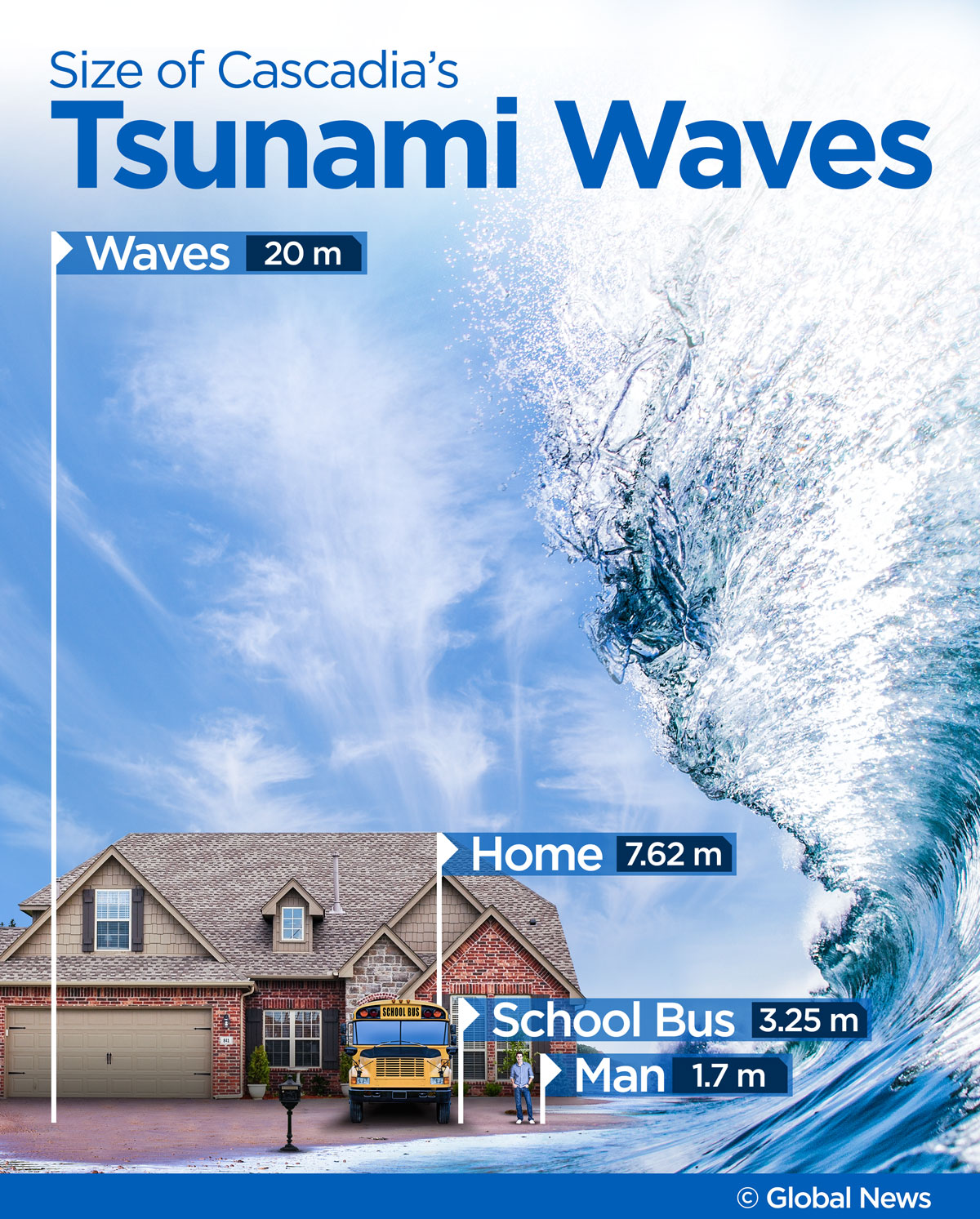Editor’s note: This story was originally published on Jan 23, 2018.

The threat of the “big one” hitting Western Canada has been looming for years. Experts say a powerful magnitude 9.0 earthquake could rip through the Pacific Coast, killings thousands and causing tsunami waves up to 20 metres high.
The last destructive earthquake like this happened on Jan. 27, 1700, and experts say it is “inevitable” that another one will hit the coast.
Below is a startling simulation of what the tsunami may have looked like in 1700 as it travelled from the U.S. to Japan after the large quake, according to the Pacific Tsunami Warning Center.
“It’s difficult to predict when it will happen again. We do know it’s occurred about 20 times in the past 10,000 years,” Dr. John Clague, an earth sciences professor at Simon Fraser University, said.
And according to Clague, we are not completely ready for the “big one.”
What is the ‘big one?’
It’s a hypothetical magnitude-9.0 earthquake that could happen along the Cascadia Subduction Zone, a 1,000 kilometre fault line that runs from northern Vancouver Island to Northern California.
The fault is a boundary between two tectonic plates: the Juan de Fuca tectonic plate and the North American plate (that we live on). The Juan de Fuca plate moves toward and eventually is shoved beneath the North American plate. But it’s become stuck for three centuries now, building up stress. When the rocks slip past each other along the fault, it will cause a “megathrust” earthquake.
And the last time this megathrust earthquake happened was in 1700.

Get breaking National news
Geological evidence indicates that such great earthquakes have occurred at least seven times in the last 3,500 years, a return interval of 400 to 600 years.
When could it hit?
“It could happen within the next 200 years,” Clague said.
Experts say there is a 12 per cent probability a Cascadia megathrust earthquake will hit in the next 50 years, according to the Office of the Auditor General of B.C.
Other experts believe the chance of it happening in the next five decades are actually one in three, according to the New York Post.
How devastating will it be?
Experts in B.C. and the U.S. estimated that the number of deaths could be more than 10,000 people with another 26,000 injured.
The west coast of Vancouver Island and the U.S. states along the Pacific Coast will be hit the hardest. But the earthquake and tsunami could also be felt in Victoria and Vancouver, Clague said.
READ MORE: Understanding earthquakes, how and why they happen
Areas on the west coast of the island, like Tofino, will have around 20 minutes warning after the earthquake before the tsunami comes, he said.
Waves could be anywhere from 15 metres to 20 metres, Chris Goldfinger, a professor of geophysics at Oregon State University, told CNN.
READ MORE: Alaska earthquake triggered very small tsunami but B.C. is very lucky, expert says
“Further inland and into the Strait of Georgia, it would take a longer period of time. Victoria would have about an hour warning and Vancouver would have quite a bit more time,” Clague said.
“Once the tsunami moves up the Strait it would tend to weaken. So it would not be as devastating like in Tofino.”
Is Canada ready?
Canada has not been rocked by an earthquake of this magnitude in centuries, so Clague said it’s difficult to be “completely ready.”
“But we are learning more and doing a better job of alerting people,” he said. “We now have some good analogues for what a tsunami and earthquake of this size would do.”
An example is the magnitude 9.0 earthquake that rattled northeastern Japan in 2011, claiming at least 15,000 lives and leaving more than half a million people homeless. This earthquake triggered a powerful tsunami — sending waves reaching up to 40 metres high into the coastline, destroying entire towns and triggering one of the world’s worst nuclear disasters.
And there was the Indian Ocean tsunami in 2004 that killed more than a quarter of a million people — making it one of the most deadly natural disasters in modern history.
Clague said the scale of these disasters are examples of what “we can expect” from the Cascadia earthquake. And now Canada is doing its best to prepare, he said.
“A lot of the preparedness is alerting people what to do and making sure there is a realistic evacuation process,” Clague said.
British Columbia learns about potential tsunamis from the U.S. National Tsunami Warning Center. The centre uses seismometers and sea level measuring stations, which send real-time data to national and regional warning centres, to determine whether there’s a risk.
He said the B.C. government and municipalities are also investing in buildings that can withstand the effects of earthquakes, making sure bridges are upgraded and vulnerable school systems are rebuilt. However, this takes time and costs money — so a lot more still needs to be done, he added.
Military operation
If B.C. was devastated by a massive earthquake, then a six-month military mission called “Operation Panorama” would kick in.
The 219-page plan for Operation Panorama was previously released to Global News under access-to-information laws.
After a major Pacific Coast earthquake, the report said the “casualty level is expected to be very high” and municipal and provincial resources would be overloaded. Damage to bridges and landslides would cut off places like Vancouver from other parts of the country, the report said.
Planners anticipate a range of needs the military could meet, including providing mobile kitchens, water purification, generators, helicopters, tents to house refugees, ships and recovery of bodies.
WATCH: The cost of “the big one” for the lower mainland

— With files from Global News’ Patrick Cain and the Canadian Press



















Comments